- Home
- About
- Map
- Trips
- Bringing Boat West
- Migration West
- Solo Motorcycle Ride
- Final Family XC Trip
- Colorado Rockies
- Graduates' XC Trip
- Yosemite & Nevada
- Colorado & Utah
- Best of Utah
- Southern Loop
- Pacific Northwest
- Northern Loop
- Los Angeles to NYC
- East Coast Trips
- 1 Week in Quebec
- Southeast Coast
- NH Backpacking
- Martha's Vineyard
- Canadian Maritimes
- Ocracoke Island
- Edisto Island
- First Landing '02
- Hunting Island '02
- Stowe in Winter
- Hunting Island '01
- Lake Placid
- Chesapeake
- Provincetown
- Hunting Island '00
- Acadia in Winter
- Boston Suburbs
- Niagara Falls
- First Landing '99
- Cape Hatteras
- West Coast Trips
- Utah Off-Roading
- Maui
- Mojave 4WD Course
- Colorado River Rafting
- Bishop & Death Valley
- Kauai
- Yosemite Fall
- Utah Off-Road
- Lost Coast
- Yosemite Valley
- Arizona and New Mexico
- Pescadero & Capitola
- Bishop & Death Valley
- San Diego, Anza Borrego, Joshua Tree
- Carmel
- Death Valley in Fall
- Yosemite in the Fall
- Pacific Northwest
- Utah Off-Roading
- Southern CA Deserts
- Yosemite & Covid
- Lake Powell Covid
- Eastern Sierra & Covid
- Bishop & Death Valley
- Central & SE Oregon
- Mojave Road
- Eastern Sierra
- Trinity Alps
- Tuolumne Meadows
- Lake Powell Boating
- Eastern Sierra
- Yosemite Winter
- Hawaii
- 4WD Eastern Sierra
- 4WD Death Valley +
- Southern CA Deserts
- Christmas in Tahoe
- Yosemite & Pinnacles
- Totality
- Yosemite & Sierra
- Yosemite Christmas
- Yosemite, San Diego
- Yosemite & North CA
- Seattle to Sierra
- Southwest Deserts
- Yosemite & Sierra
- Pacific Northwest
- Yosemite & South CA
- Pacific Northwest
- Northern California
- Southern Alaska
- Vancouver Island
- International Trips
- Index
- Tips
- Books
- Photos/Videos
- Search
- Contact
Greenville, IL to Miami
Thursday, September 22, 2016 - 6:15pm by Lolo373 miles and 7.5 hours from our last stop - 1 night stay
Travelogue
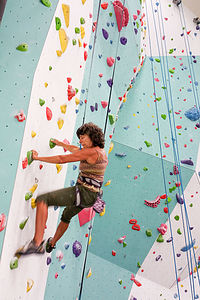 Zenith Climbing Center in Springfield, MOWhen we hit St. Louis, rather than continuing west on I70, we headed southwest on I44 to eventually link up with I40, a much gentler alternative, in terms of mountain passes and steep grades, than I70 or I80.
Zenith Climbing Center in Springfield, MOWhen we hit St. Louis, rather than continuing west on I70, we headed southwest on I44 to eventually link up with I40, a much gentler alternative, in terms of mountain passes and steep grades, than I70 or I80.
I didn’t think I could take another day where the highlight was stopping at a Subway in a truck stop, so I suggested we look for a rock climbing gym to get in some physical exercise, and break up the monotony of the drive, and hopefully combat the ill effects of a diet of Subway heroes.
My first step in implementing this bold plan was to use the Waze phone app to plot our route. Then I performed a search along route for terms that might appear in the name of a climbing gym, such as “rock,” “granite,” “climbing,” etc.
Bingo! I found the Zenith Climbing Center in Springfield, Missouri, just 7 miles south of I44.
The second challenge was to find out if we could park our 45-feet of tonnage somewhere nearby. I called the gym to ask, and was told that there was a church nearby with a very large parking lot where he felt confident we could fit.
Great! We were quite excited.
I have rarely met a climbing gym I didn’t like, and Zenith was no exception. It was practically brand new and almost completely empty, because most of the staff and people that climb here were off at a climbing competition in nearby Arkansas, a competition that Herb had actually heard of. It’s called 24 Hours of Horseshoe Hell, and is very unique in that you are scored on how many routes you can complete in a 24 hour period.
So, basically we had the gym to ourselves, which was great. It took us awhile to get used to the route grades here. Every gym tends to rate the difficulty of climbs differently, so we had to kind of figure out through trial and error which routes were appropriate for our abilities. In the case of this gym, the gradings were really stiff, meaning that they were really hard for their grade. While in some gyms, I can comfortably do 5.10s and even the occasional 5.11a, I struggled through 5.9s here – much more realistic to outdoor climbing.
Invigorated from our climbing session, we continued on another 2 hours before settling in for the night in a Microtel Inn in Miami, Oklahoma.
I don’t even remember what we had for dinner, but if I was to guess, it was a Subway hero or salad.
Description
Driving I44 towards I40 with a stop for the night in Miami, Oklahoma
Brother's house in Ohio to Greenville
Wednesday, September 21, 2016 - 6:15pm by Lolo386 miles and 8 hours from our last stop - 1 night stay
Travelogue
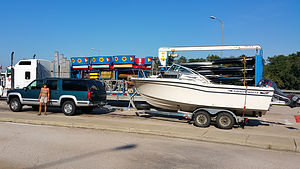 The first of many many truck stopsWe said our goodbyes to my brother and his family and continued our way west. Fortunately, it was an uneventful, mole-free day – just more truck stops, Subway sandwiches, and Econo Lodges.
The first of many many truck stopsWe said our goodbyes to my brother and his family and continued our way west. Fortunately, it was an uneventful, mole-free day – just more truck stops, Subway sandwiches, and Econo Lodges.
After 8 hours of driving, I was desperate for some form of fitness, but there really was no place to run from the motel. That was why I was so happy to find that the motel had a fitness center with a treadmill. I’m not really a treadmill fan, but beggars can’t be choosers, so I figured why not.
That evening I ran for 45 minutes, longer than I ever do on a treadmill. In fact, Herb even came to look for me at one point to see if I was okay. I was so glad to see him, because I couldn’t get the AC working and it was really hot in there. My hero Herb came to the rescue and plugged it in – why didn’t I think of that?
We ate our Subway salads, watched some TV, and went to bed. I hope this wasn’t going to become too much of a pattern.
Description
Drive along I70 from Ohio, through Indiana, to an Econo Lodge in Greenville, Ohio
Breezewood, PA to Brother's House in New Albany
Monday, September 19, 2016 - 6:15pm by Lolo284 miles and 5.5 hours from our last stop - 2 night stay
Travelogue
 Boat makes it to Jimmy'sWe hit the road early – not much else to do in an Econo Lodge in Breezewood, PA, and started the 6-hour drive to my brother’s house in New Albany, Ohio. He had arranged a place for us to park our 45-feet of stress just across from his house in an area where they were constructing new homes.
Boat makes it to Jimmy'sWe hit the road early – not much else to do in an Econo Lodge in Breezewood, PA, and started the 6-hour drive to my brother’s house in New Albany, Ohio. He had arranged a place for us to park our 45-feet of stress just across from his house in an area where they were constructing new homes.
Things were going along pretty smoothly until about ½ hour away from Jimmy’s, when we began hearing a rattling sound coming from the boat trailer. Herb stopped and saw that the crack on the fender had extended to the point where he was concerned it would fall off. We tried calling a couple of boat trailer places to see if they had a replacement fender, but no luck. Instead we stopped at a Home Depot and Herb bought some clamps to keep it in place.
After leaving Home Depot, we began hearing a new sound - scraping noise coming from the driver side front tire, which seemed to correspond with the rotation of the wheel.
Herb said he felt like he was playing Whack-a-Mole, and the moles were winning.
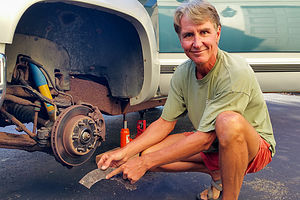 Rusty loose dust shield - Problem solvedHe had no idea what the new problem was, nor how long it would take to repair, so we told my brother we might be moving in for awhile.
Rusty loose dust shield - Problem solvedHe had no idea what the new problem was, nor how long it would take to repair, so we told my brother we might be moving in for awhile.
As with our day at the Jersey shore, we decided to just enjoy the evening with my brother and his family, and not worry about the problem until the morning – it seemed like we were doing a lot of that lately.
Bright and early the next morning, Herb took the tire off the Suburban and saw that a piece of the very rusty, disc brake dust shield had broken off and was rattling around causing the noise. Since the broken off piece wasn’t essential to the braking system, Herb just removed it. When I saw how rusty things looked behind the wheel, I seriously questioned our wisdom in driving this thing across the country. However, at this point, there wasn’t much of a choice.
Since we were able to whack our second mole relatively quickly, we had the rest of the day to enjoy. My brother brought us to the lovely Inniswood Botanical Garden and Nature Preserve in nearby Westerville, Ohio, where we spent a few peaceful hours strolling through the woodlands and various gardens.
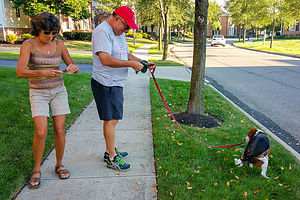 Charlie in actionBefore leaving the next morning we accompanied Jim on his morning constitutional with Charlie. Walking Charlie was quite a unique experience. He was so interested in sniffing everything along the way that he actually walked sideways, sort of like a crab, while my brother dragged him along. I had never seen anything like it. He also liked to mark his turf frequently with a little poop - I think there were about 3 of these "markings" on this walk alone. When we asked Jim if Charlie had been trained at all, he said “No, that would take away his personality.” Ok good. At least he hadn’t been ripped off by a dog trainer.
Charlie in actionBefore leaving the next morning we accompanied Jim on his morning constitutional with Charlie. Walking Charlie was quite a unique experience. He was so interested in sniffing everything along the way that he actually walked sideways, sort of like a crab, while my brother dragged him along. I had never seen anything like it. He also liked to mark his turf frequently with a little poop - I think there were about 3 of these "markings" on this walk alone. When we asked Jim if Charlie had been trained at all, he said “No, that would take away his personality.” Ok good. At least he hadn’t been ripped off by a dog trainer.
Time to hit the road. I am always sad leaving my brother's house. He and his wife are such great hosts that a visit with them is always a treat. The good food and laughter definitely lifted our spirits.
Description
I70 to my brother Jimmy's house in New Albany, Ohio
New Jersey to Breezewood
Sunday, September 18, 2016 - 6:15pm by Lolo250 miles and 5 hours from our last stop - 1 night stay
Travelogue
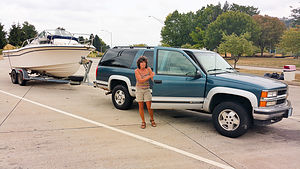 Hitting the RoadThe day of reckoning was upon us.
Hitting the RoadThe day of reckoning was upon us.
After showering off the gasoline that had poured on his arms and chest during the fuel line repair, Herb put on a brave face and said, “Let’s go.”
I have to admit that I was quite nervous about our chances of making it cross country without a breakdown or calamity of some sort, but if I had to do it, I couldn’t have had a more competent pilot than Herb.
Our first planned destination was my brother’s house in New Albany, Ohio, but since we got such a late start because of the fuel line repair, we decided that we would just try to get a few hours of driving under our belt and then get to Jimmy’s relatively early the following day.
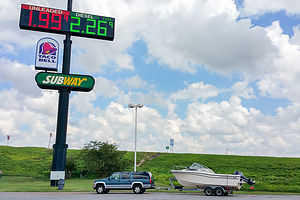 Not another Travel Center Subway!!Knock on wood, everything seemed to be working fine and the Suburban, as it always has, ran like a champ. I kept a running text dialogue going on with Herb’s brother and our friend Randy, both capable mechanics, who were very interested, and concerned, with our progress. Randy considered our journey more analogous to that of a NASA space mission than a typical road trip, and dubbed our vehicle the SuburbanShip (the lunatic module).
Not another Travel Center Subway!!Knock on wood, everything seemed to be working fine and the Suburban, as it always has, ran like a champ. I kept a running text dialogue going on with Herb’s brother and our friend Randy, both capable mechanics, who were very interested, and concerned, with our progress. Randy considered our journey more analogous to that of a NASA space mission than a typical road trip, and dubbed our vehicle the SuburbanShip (the lunatic module).
We soon realized that finding places to eat and sleep were going to be a challenge, because with our 45-feet of length (Suburban plus boat), we were more like a semi than a car. It looked like it was going to be truck stops all the way.
We had our first, of what was to be far too many, Subway heroes at a Pilot Travel Center and bought a salad to have in our motel room that night. Fortunately, along the interstates, most motels had truck parking, so we were able to settle in at an Econo Lodge in Breezewood, PA, without too much difficulty.
Description
Making our way west on I76 through Pennsylvania to an Econo Lodge.
Flying back to our roots
Monday, September 12, 2016 - 6:00pm by Lolo178 miles and 3 hours from our last stop - 6 night stay
Travelogue
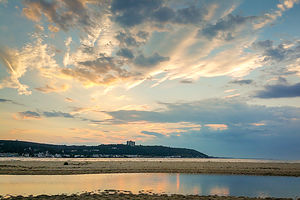 Sunset over Sandy Hook BayBeing back in New Jersey felt so normal – I guess it should, as it was our home for 60 years. The flight went smoothly, and we were at my brother’s house in Monmouth Beach in time for dinner that night.
Sunset over Sandy Hook BayBeing back in New Jersey felt so normal – I guess it should, as it was our home for 60 years. The flight went smoothly, and we were at my brother’s house in Monmouth Beach in time for dinner that night.
I couldn’t help comparing the ease of our arrival on the East Coast with the arduous journey we had ahead of us driving back to the West Coast in a 21-year-old, rusty Suburban, towing a 20-foot Grady White. For now, I would try not to think about it and just enjoy visiting old friends and places – and Herb could enjoy getting reacquainted with the underside of the Suburban.
The first two days were spent pretty much as planned, working on the vehicles to ensure they would safely get across the country. Lots of work for Herb, and his very helpful brother, but at least there were no major surprises.
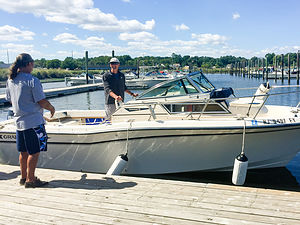 Final cruise in the AtlanticOn the third day, Herb felt confident enough in his progress to take the day off so that we could head up to our hometown in north New Jersey to visit with friends. We even made time to climb at Gravity Vault, our old climbing gym before going out to dinner at the Saddle River Inn.
Final cruise in the AtlanticOn the third day, Herb felt confident enough in his progress to take the day off so that we could head up to our hometown in north New Jersey to visit with friends. We even made time to climb at Gravity Vault, our old climbing gym before going out to dinner at the Saddle River Inn.
On day 4, we decided the boat needed to say goodbye to the Atlantic Ocean, so we launched it in Keyport and took it for a 25-mile cruise over to Sandy Hook and back. Afterwards we went out to dinner with Herb’s brother and his wife at a typical Jersey Shore establishment called On the Deck - and that is exactly where we sat – “on the deck” overlooking the Bay.
Being able to sit outside comfortably is probably the thing we miss most (besides our friends) about the East Coast. The weather is absolutely beautiful in Sonoma County, but the swings in temperature during the day are huge. It can be 80+ degrees during the day, but come nightfall, it quickly drops into the 50s.
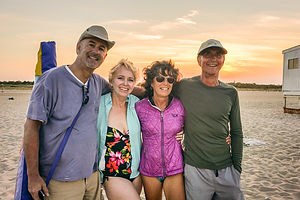 There's nothing like old friendsWe pretty much were ready to hit the road on Saturday, but we added one more day in New Jersey, so that we could meet two very dear friends at the beach on Sandy Hook, which is part of the Gateway National Recreation Area. On the way to meet them at the beach, we stopped at a McDonalds for coffee. When we got back to the Suburban, we smelt gasoline. Herb bent down to look under the truck, and sure enough, there was gas leaking from our fuel line.
There's nothing like old friendsWe pretty much were ready to hit the road on Saturday, but we added one more day in New Jersey, so that we could meet two very dear friends at the beach on Sandy Hook, which is part of the Gateway National Recreation Area. On the way to meet them at the beach, we stopped at a McDonalds for coffee. When we got back to the Suburban, we smelt gasoline. Herb bent down to look under the truck, and sure enough, there was gas leaking from our fuel line.
The leak was pretty slow and our friends were already on their way to the beach, so we decided to just go ahead with our plans for the day, and worry about the leak tomorrow. We put a pan under the leak while we were at the beach.
I’d have to say that I was very proud of Herb. I know how frustrated and concerned he must have been about the leak, but he did manage to put it out of his mind for the day, and we had a really terrific time – perhaps the beers helped.
While at the beach, I remembered that there is a second thing that I miss most about the East Coast – sandy beaches where the water is actually warm enough to flop around in the waves. Northern California beaches are drop-dead gorgeous, but nobody (except wet-suit clad surfers) actually goes in the water.
 Rusty SuburbanBefore leaving New Jersey on Sunday, we (and by we, I mean Herb) had the not so tiny issue of the leaky fuel line to deal with first. Thank God for Herb’s brother’s knowledge.
Rusty SuburbanBefore leaving New Jersey on Sunday, we (and by we, I mean Herb) had the not so tiny issue of the leaky fuel line to deal with first. Thank God for Herb’s brother’s knowledge.
What Herb had to do was cut out the rusty section of the fuel line, which was leaking, and quickly replace the missing section with rubber hosing. Right before he began the surgery, his brother wrapped rags around Herb’s upper arms. When Herb looked at him a bit quizzically, Ron responded, “When the gas starts pouring out, it can really burn your armpits.” Oh boy. This was not going to be fun.
However, Herb, my hero, worked so quickly that his armpits were saved and the patched together fuel line was no longer leaking.
It was time to hit the road.
We hitched the boat trailer to the Suburban, said our goodbyes, and with much anxiety and trepidation, started the long drive west. Why did the Donner Party keep coming to mind?
Description
I think "New Jersey" speaks for itself.
Home
Saturday, November 5, 2016 - 10:30am by Lolo183 miles and 4 hours from our last stop - 1 night stay
Travelogue
Home sweet new home! It's a whole lot easier ending a great vacation when there is a wonderful new home waiting for us at the end in Sonoma Valley
Description
Our new home in Santa Rosa
Pinnacles National Park
Tuesday, November 1, 2016 - 10:15am by Lolo190 miles and 4.5 hours from our last stop - 4 night stay
Travelogue
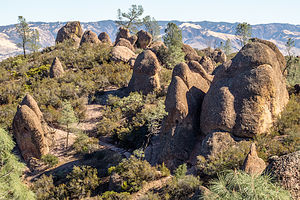 High Peaks RegionIt has been far too long since we’ve been to a new national park, so we were quite excited to be heading to Pinnacles. It was new, not only to us, but it was new to the National Park list – promoted in 2013 from a National Monument.
High Peaks RegionIt has been far too long since we’ve been to a new national park, so we were quite excited to be heading to Pinnacles. It was new, not only to us, but it was new to the National Park list – promoted in 2013 from a National Monument.
The park is divided into an eastern and a western section, without any roads connecting them. Since the campground and most of the action is located in the eastern part, that is where we headed.
I had made camping reservations a few days ago, so we were set. In my haste to make a reservation on Recreation.gov, I did not notice that there were electric sites, so I booked a non-electric one. Although we can dry camp just fine in our Lazy Daze, we certainly do appreciate the amenities electricity can provide – our little heater for the cold nights, the ability to keep lights on without draining the battery, microwave, hair dryer, etc. It would have especially been nice since the days were so short and it was dark by 5:30.
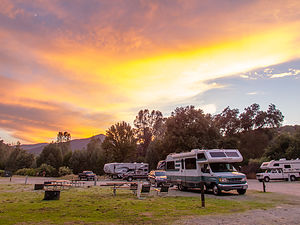 Pinnacles CampgroundHowever, the Pinnacles Campground actually does have electric sites, which we discovered on a late afternoon stroll through the campground on the 3rd of our 4 nights there. Herb gave me a bit of a dirty look, as I am supposed to be in charge of such things and apparently had failed miserably. Oops. Unfortunately, the office was already closed, but we were back there first thing in the morning to switch our site.
Pinnacles CampgroundHowever, the Pinnacles Campground actually does have electric sites, which we discovered on a late afternoon stroll through the campground on the 3rd of our 4 nights there. Herb gave me a bit of a dirty look, as I am supposed to be in charge of such things and apparently had failed miserably. Oops. Unfortunately, the office was already closed, but we were back there first thing in the morning to switch our site.
Pinnacles is quite small by national park standards – just 26,000 acres, but I took that as a personal challenge to conquer all its nooks and crannies in our three days here.
Day 1 – Condor Gulch, High Peaks, and Rim Trail Hike
If you only have one day to spend in the Park, I think the High Peaks Trail is far and away the best thing to do. It’s fairly strenuous – 7.5 miles with a 2,236-foot elevation gain, but there is much reward along the way.
We started off by driving to the Bear Gulch Day Area where the Condor Gulch Trail begins. From there, we hiked up a smooth, winding trail, constantly keeping our eyes out for California Condors, which according to neighbors of ours that had visited the park in late May, were quite abundant and not very shy of people – quite disconcerting considering they do have a 9-foot wingspan.
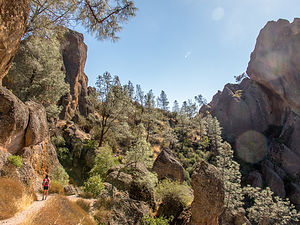 High Peaks RegionAfter about a mile, we came to an overlook and gazed out over the canyon we had just climbed, but try as we might, there were no condors to be seen. Shortly after the overlook, we met a fellow hiker coming down from the High Peaks who told us that he hikes this trail all the time, and this was one of the few times that he had not seen one.
High Peaks RegionAfter about a mile, we came to an overlook and gazed out over the canyon we had just climbed, but try as we might, there were no condors to be seen. Shortly after the overlook, we met a fellow hiker coming down from the High Peaks who told us that he hikes this trail all the time, and this was one of the few times that he had not seen one.
We continued up the Condor Gulch trail for about another ¾ of a mile before turning left (west) onto the High Peaks Trail. The scenery had already been quite impressive, but now things got really good as we wound our way through the pinnacle formations that give the park its name. At about mile 2.3, we came to a junction with the Tunnel Trail, where hikers have the choice of continuing on the “Steep and Narrow” High Peaks Trail, or taking the milder, but slightly longer Tunnel Trail. Both converge again at the Juniper Canyon trailhead in about 0.7 miles.
We chose to take the more exciting High Peaks Trail, which led us through narrow passageways, and up and over steep rock formations, with near-vertical drop-offs off to side. Fortunately, in the more precarious sections there were steps cut into the rock to form staircases and handrails to grip onto. As long as I can hold onto something, I am usually okay with heights, so I found this section of the trail really fun.
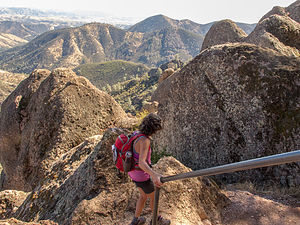 Precarious section of High Peaks TrailWhen we converged once more with the Juniper Canyon Trail near Scout Peak, we scrambled up the rocks alongside the trail to get a better view while eating lunch. To pass the time searching for non-existent condors, I used my Iphone to read Herb fun facts about condors from Wikipedia. For example, we learned that California condors do not have a sense of smell and have to rely on other scavengers, like vultures, to find dead carcasses to eat. Then they just swoop down, scare the smaller birds away, and feast. No wonder they almost went extinct. They also defecate on their legs to reduce their body temperature. Not exactly great lunchtime conversation.
Precarious section of High Peaks TrailWhen we converged once more with the Juniper Canyon Trail near Scout Peak, we scrambled up the rocks alongside the trail to get a better view while eating lunch. To pass the time searching for non-existent condors, I used my Iphone to read Herb fun facts about condors from Wikipedia. For example, we learned that California condors do not have a sense of smell and have to rely on other scavengers, like vultures, to find dead carcasses to eat. Then they just swoop down, scare the smaller birds away, and feast. No wonder they almost went extinct. They also defecate on their legs to reduce their body temperature. Not exactly great lunchtime conversation.
At about 5 miles into our hike, we came to the junction with the Rim Trail and decided to take it rather than go directly back to the car. One of the assignments the boys had given us on our visit to Pinnacles was to research the rock climbing possibilities, and the specific climbs they wanted us to look at were along the Rim Rock/Moses Spring loop.
The Rim Trail actually goes along the top of climbing routes, rather than along their base. We took a path labeled Discovery Wall, which was one of our homework assignments, and spoke to a few volunteer climbers that were working on replacing bolts on the wall. The type of rock in Pinnacles is volcanic breccias, which is much more delicate and likely to break off than walls of granite or basalt. That’s why, despite its rather close proximity to San Francisco, the boys had avoided climbing here as of yet. The thought of a hold coming off in your hand is a bit disconcerting.
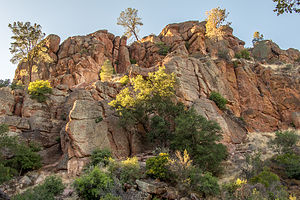 Along the Rim TrailHowever, these guys certainly seemed to love climbing here and had done so dozens of times. They also told us about a wall a short distance away called Top Rope Rock, where Herb would not have to lead a climb, but could just set up a top rope on for us to use -- good idea, as I am not 100% confident in my ability to belay him on lead. Perhaps tomorrow.
Along the Rim TrailHowever, these guys certainly seemed to love climbing here and had done so dozens of times. They also told us about a wall a short distance away called Top Rope Rock, where Herb would not have to lead a climb, but could just set up a top rope on for us to use -- good idea, as I am not 100% confident in my ability to belay him on lead. Perhaps tomorrow.
We continued our hike along the Rim Trail to the Reservoir. From there, we could have gone through Bear Gulch Cave, but it was getting late, we were tired, and really had no desire to crawl around in a cave. Instead we walked upright like Cro Magnons on the Moses Spring Trail. Along the way, we passed The Monolith, the second rock wall we were asked to research.
It had been a great day – 7.5 miles of great scenery and a good workout.
We got back to the campground just in time to bring out our beach chairs and sit in the sun a half hour before it dipped behind the mountains and things cooled down real fast. I hate these short days, especially without electricity in the motorhome.
Day 2 – Rock Climbing on Top Rope Wall
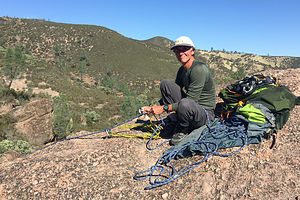 Herb setting up on Top Rope WallUntil I get my lead belay certification, Herb and I are somewhat limited in what we can climb when it is just the two of us. That is something I really need to work on. However, fortunately, Pinnacles had a Top Rope Wall, also called Teaching Rock, which was perfect for us.
Herb setting up on Top Rope WallUntil I get my lead belay certification, Herb and I are somewhat limited in what we can climb when it is just the two of us. That is something I really need to work on. However, fortunately, Pinnacles had a Top Rope Wall, also called Teaching Rock, which was perfect for us.
It was right near the Discovery Wall where we had talked to the climbers yesterday. We parked at the Moses Springs parking lot, hiked 0.1 miles along the Moses Spring trail, hung a right onto the High Peaks trail for another 0.3 miles, then turned left on the Rim Trail for another 0.2. From there a side trail off to the left brought us to the top of the camel hump, aka Teaching Rock, aka Top Rope Wall, aka Lolo Rock.
Anchors were already set up on top of the rock, so all Herb had to do was setup a top rope, throw both ends of the rope down to the base of the rock, and come down to the base himself via the walk-off path around the side. This allowed us to safely belay each other and climb.
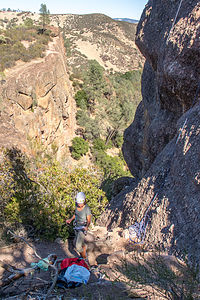 Climbing at Top Rope WallThe routes to the top varied in difficulty from 5.6 to 5.9. We weren’t exactly sure which route was which, but I certainly hope that the first one we tried was the 5.9, because I got stuck below the bulge and couldn’t get much further. Herb, of course, did it just fine and then suggested that I try going slightly to the right around the bulge rather than straight up over it. Although still challenging for me, I was able to get the complete climb. We did another one to the left of the first climb as well.
Climbing at Top Rope WallThe routes to the top varied in difficulty from 5.6 to 5.9. We weren’t exactly sure which route was which, but I certainly hope that the first one we tried was the 5.9, because I got stuck below the bulge and couldn’t get much further. Herb, of course, did it just fine and then suggested that I try going slightly to the right around the bulge rather than straight up over it. Although still challenging for me, I was able to get the complete climb. We did another one to the left of the first climb as well.
It was very interesting rock – very different from anything we have climbed on before. There were all these angular pieces of rock that looked like they were cemented to the rest of the rock. Some of them were good to grab onto – others, not so much. Still it was lots of fun and satisfying. Plus, now I could say I climbed at Pinnacles before the boys did.
It was a beautiful day and our campsite was actually quite nice, so we went back around 3:00, so we could spend an hour or two just relaxing and reading in the beach chairs.
Day 3 – Hike to West side of Park
As I mentioned earlier, Pinnacles is a small national park, so given a few days, one can pretty much walk all its trails. So, that was pretty much our goal for the day – to hike the Old Pinnacles and Balconies Trail over to the west side of the park and then come back via the High Peaks Trail. Also, we hoped that going through the High Peaks section of the park again would give us another shot at seeing California Condors.
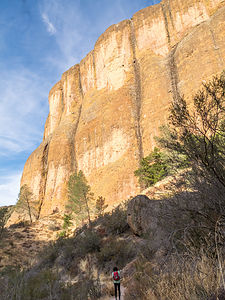 Old Pinnacles TrailThere aren’t a whole lot of roads in the park, so getting to trailheads is quite simple. This time, instead of veering left at the fork for the Bear Gulch Day Area, we hung a right on Old Pinnacles Road to the trailhead parking at the end.
Old Pinnacles TrailThere aren’t a whole lot of roads in the park, so getting to trailheads is quite simple. This time, instead of veering left at the fork for the Bear Gulch Day Area, we hung a right on Old Pinnacles Road to the trailhead parking at the end.
From the parking lot, we walked about 0.2 miles to the junction of the Old Pinnacles and Bench Trails. Although most of the hiking guides suggested taking a left onto the Bench Trail and doing the loop clockwise, we chose to stay right on the Old Pinnacles Trail, because we wanted to do the High Peaks Trail section in the opposite direction from what we had done two days ago – that way the views would be different and it wouldn’t feel like a repeat.
The first 2 miles or so of the Old Pinnacles Trail were along a wide sandy trail through a dry canyon populated with pine trees and brush. No big views or big climbs, but a very pleasant stroll. At about 2.1 miles we arrived at Balconies Cave. I think most people hike this trail because of the cave, but we’ve done so many caves and scrambling over rocks in our day, that we decided to literally take the high road – the Balconies Cliff Trail which went above it.
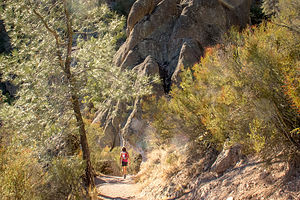 Juniper Canyon TrailAt about 4 miles, we came to the Chaparral Ranger Station and Parking Area, which is the western access to Pinnacles National Park. From there we hung a left onto the Juniper Canyon Trail where the scenery and the topography began to change. For the next 2 miles, we climbed over 1,000 feet through a series of switchbacks with views of pinnacles and interesting rock formations across the canyon.
Juniper Canyon TrailAt about 4 miles, we came to the Chaparral Ranger Station and Parking Area, which is the western access to Pinnacles National Park. From there we hung a left onto the Juniper Canyon Trail where the scenery and the topography began to change. For the next 2 miles, we climbed over 1,000 feet through a series of switchbacks with views of pinnacles and interesting rock formations across the canyon.
At the trail junction for the Tunnel Trail, we turned left (northeast) onto it and continued climbing until the junction with the High Peaks Trail at about mile 6. This was the junction we came to from the other direction two days ago, where we chose to go south through the "Steep and Narrow" section with handrails to keep from falling off the steep drop-offs.
However, today we were headed east on the High Peaks Trail back towards the Old Pinnacles trailhead. All that climbing we had done up to now finally paid off, because it was pretty much all downhill from here.
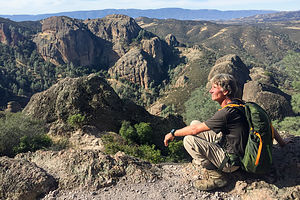 High Peaks HerbThe next mile was the only repeat from our previous hike, the section between the Tunnel Trail and Condor Gulch junctions – but a section well worth repeating, as it is probably the most scenic part of the park, with amazing views of the rock spires rising out of the pine and chaparral-covered ridges towards Bear Gulch in the south and the bulging canyon walls of the Balconies to the north.
High Peaks HerbThe next mile was the only repeat from our previous hike, the section between the Tunnel Trail and Condor Gulch junctions – but a section well worth repeating, as it is probably the most scenic part of the park, with amazing views of the rock spires rising out of the pine and chaparral-covered ridges towards Bear Gulch in the south and the bulging canyon walls of the Balconies to the north.
As we continued along the 2-mile section of the High Peaks Trail between Condor Gulch and the Bench Trail, the views of rock spires and monoliths gave way to views of ridges and canyons – less dramatic, but still quite lovely.
When we reached the Bench Trail, we turned left (north) and hiked about another mile back to our car. All in all, we had hiked 9.8 miles with a 1,885-foot elevation gain through some very awesome scenery.
It was time for a cold beer back at the campsite where we now had electricity – Woo Hoo!
I forgot to mention that once again, despite our best efforts, we had not seen a California Condor, even though we hiked for a second time through the High Peaks region, which is where they are most commonly seen.
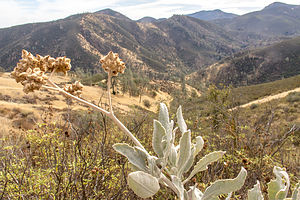 Descending the High Peaks TrailHowever, later that afternoon while relaxing in our beach chairs, sipping our well-deserved beers, gazing at the sky above the campground, we spotted some very large birds riding the thermals along the ridge.
Descending the High Peaks TrailHowever, later that afternoon while relaxing in our beach chairs, sipping our well-deserved beers, gazing at the sky above the campground, we spotted some very large birds riding the thermals along the ridge.
We couldn’t make out the distinctive white markings under their wings from this distance, so I went over to the campground viewing area and looked through one of the telescopes. I was joined by a gentleman quite knowledgeable about birds that confirmed for me that they were indeed condors and that immature ones do not yet have the white markings.
If I had only known that condors are more easily spotted from a beach chair with beer in hand, I wouldn’t have had to do all that vigorous hiking.
After 10 nights out on the road dry camping, we spent our first evening in a water/electric site enjoying the wonders of electricity, as if for the first time – microwaving, blow drying my hair, turning lights on, running the heat, watching movies – even if we didn’t need to.
Pinnacles is truly a wonderful park, and one to which I am sure we will return to again and again – or at least until I have fed a condor out of my hand.
Description
Pinnacles National Park
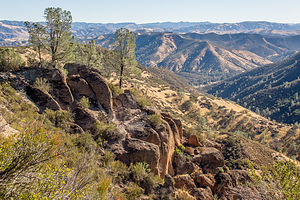 View from Condor Gulch TrailIn 2013, 26,000-acre Pinnacles National Monument graduated to the status of National Park. The park is located a little over two hours south of San Francisco, east of the Salinas Valley. The park is named for the towering rock spires that rise abruptly out of the chaparral-covered Gabilan Mountains.
View from Condor Gulch TrailIn 2013, 26,000-acre Pinnacles National Monument graduated to the status of National Park. The park is located a little over two hours south of San Francisco, east of the Salinas Valley. The park is named for the towering rock spires that rise abruptly out of the chaparral-covered Gabilan Mountains.
These rock formations are the remnants of an extinct volcano that erupted 23 million years ago. As the Pacific plate crept northward along the San Andreas Fault, it split a big chunk off from the main body of this volcano and dragged it 200 miles northwest to where Pinnacles is today. Millions of years of weathering and erosion have resulted in the formations you see today.
The rock in Pinnacles is quite unique. It is breccias, a type of sedimentary rock composed of broken angular fragments of minerals or rock cemented together by a fine-grained matrix of smaller particles.
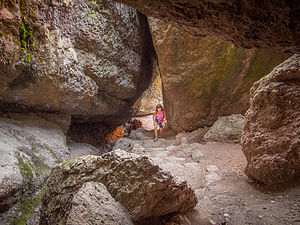 Bear Gulch CaveEarthquake and volcanic activity were also responsible for the Pinnacles’ Balconies and Bear Gulch talus caves, formed when boulders fell into deep, narrow gorges and lodged between the rock walls, forming a roof over the canyon. Today, these caves are home to several species of bats.
Bear Gulch CaveEarthquake and volcanic activity were also responsible for the Pinnacles’ Balconies and Bear Gulch talus caves, formed when boulders fell into deep, narrow gorges and lodged between the rock walls, forming a roof over the canyon. Today, these caves are home to several species of bats.
The Park is divided by the rock formations into an eastern and a western section with no road connecting the two. The Visitor Center and Campground are located on the east side of the park.
Activities in the park include:
- Hiking the 30 miles of trails
- Rock climbing – however, the volcanic breccias and tuff is weak compared to the granite and basalt rock of other climbing areas
- Exploring the Bear Gulch and Balconies talus caves
- Watching California Condors soar on the thermal drafts over the high peaks section of the park
Yosemite National Park
Tuesday, October 25, 2016 - 10:00am by Lolo255 miles and 6 hours from our last stop - 7 night stay
Travelogue
Day 1 – Hiking in Hetch Hetchy
 Intact Hetch Hetchy BridgeAfter 30 years of visiting Yosemite National Park and having hiked every trail the Valley has to offer and most of those in Tuolumne Meadows as well, it was finally time to explore the often forgotten and rarely visited Hetch Hetchy, in the northwest corner of the park.
Intact Hetch Hetchy BridgeAfter 30 years of visiting Yosemite National Park and having hiked every trail the Valley has to offer and most of those in Tuolumne Meadows as well, it was finally time to explore the often forgotten and rarely visited Hetch Hetchy, in the northwest corner of the park.
This was the place that famed conservationist John Muir thought rivaled Yosemite Valley in grandeur and fought so hard to protect from the politically powerful men in San Francisco that wanted to dam the river and turn its valley into a reservoir. As we all know, Muir lost the good fight and many believe that the loss hastened his death in 1914, a year after a bill was signed to fund the dam project.
Anyone interested in learning more about this controversial battle should definitely attend one of the weekly performances of “Conversation with a Tramp: An Evening with John Muir” given every Wednesday night at the Yosemite Theater (behind the Visitor Center). It is such an unbelievably worthwhile experience. The actor, Lee Stetson, has been playing the role of John Muir since 1983, and trust me, he will keep you mesmerized and totally convinced that you are back in 1913 anxiously waiting with him in his study for the news of Hetch Hetchy’s fate.
 Wapama FallsIronically, this part of the park is so much less visited than the Valley that the feeling of solitude and remoteness that surrounds one here is probably much closer to the way John Muir had experienced Yosemite.
Wapama FallsIronically, this part of the park is so much less visited than the Valley that the feeling of solitude and remoteness that surrounds one here is probably much closer to the way John Muir had experienced Yosemite.
The 40-mile drive from the Valley takes about an hour and a half. We took the Big Oak Flat Road north, but rather than turn west onto 120, we continued on Evergreen Road through the Stanislaus National Forest. This was now new territory for us. Since we were no longer officially in the park, there were some privately-run establishments, such as the Evergreen Lodge and Tavern, which I am embarrassed to say, I had no idea even existed. It looked quite quaint and cozy.
At the end of Evergreen Road, we came to the Yosemite entrance station -- that’s right, you actually have to leave Yosemite and re-enter it again to get to Hetch Hetchy.
At the entrance gate, we were extremely disappointed to hear that the 13-mile (RT) trail to Wapama and Rancheria Falls was closed after two miles because the bridges across Wapama Falls had been damaged by the heavy rains of the previous week. These same heavy rains, which had treated us to the most spectacular waterfalls we had seen in 30 years of Yosemite visits, were now going to ruin my day. I guess you can’t have it all. At least we would get to see controversial dam and reservoir, and there always was that quaint little Tavern back at the Evergreen Lodge.
From the entrance gate, we drove another 8 miles along the twisty, narrow Hetch Hetchy Road to the Day Hikers parking area by the O’Shaughnessy Dam. There was no one else here.
 Lolo and Hetch HetchyAs we walked across the dam and gazed out across the reservoir (squinting a little to block out the water), we could definitely see how John Muir compared this place to Yosemite Valley. There was even a little El Cap, just to the left of Wapama Falls. Later, we even found a miniature Half Dome. I guess we shouldn’t have been so surprised, as the same forces that formed Yosemite Valley shaped and created this valley as well.
Lolo and Hetch HetchyAs we walked across the dam and gazed out across the reservoir (squinting a little to block out the water), we could definitely see how John Muir compared this place to Yosemite Valley. There was even a little El Cap, just to the left of Wapama Falls. Later, we even found a miniature Half Dome. I guess we shouldn’t have been so surprised, as the same forces that formed Yosemite Valley shaped and created this valley as well.
At the end of the dam, we walked through a 500-foot, dark tunnel, before turning right onto the trail to Wapama and Rancheria Falls. In spring time there are usually three waterfalls to see along this trail, but for whatever reason, Tueeulala Falls, at 1 ½ miles, was not running.
We finally came across some fellow hikers – two girls who were turning back because they encountered a black bear on the trail. Oh great. Although I hesitated to continue at first, Herb encouraged me to forge ahead, suggesting we make noise to announce our presence along the way. While Herb chose to taunt the bear with a chant of, “No grizzly,” I more wisely just tooted my whistle every 100 yards or so. We’ll never know whose method worked better, but in either case, we never came across the bear.
As we neared Wapama Falls at about 2.3 miles, we came to the “trail closed” sign we had been warned about. They obviously had placed the sign well before any trail issues, so we decided to just take a little peek around it with the hope of getting a photo of the falls and the damaged bridge.
 Rancheria FallsWhen we reached the falls and the series of bridges that crossed it, we were surprised to discover that they were perfectly intact, with the exception of one 6-foot section of railing down on the first one. We have hiked some pretty precarious trails over the years that have truly frightened and humbled me – and I admire the National Parks for giving people the freedom to make their own decisions as to what they can safely handle -- but this one did not seem to be a safety issue at all.
Rancheria FallsWhen we reached the falls and the series of bridges that crossed it, we were surprised to discover that they were perfectly intact, with the exception of one 6-foot section of railing down on the first one. We have hiked some pretty precarious trails over the years that have truly frightened and humbled me – and I admire the National Parks for giving people the freedom to make their own decisions as to what they can safely handle -- but this one did not seem to be a safety issue at all.
So, rightly or wrongly we continued on, past lovely Wapama Falls, excited that we could now complete the 13-mile hike we had originally planned. For the next 4 miles, the trail traced the reservoir’s edge, often rising high above the water, providing fabulous views of Kolana Rock across the water.
At 6.5 miles, we reached Rancheria Falls, which unlike the free-falling Wapama Falls, is a series of rolling cascades pouring over terraces of polished granite. It was a lovely spot to have lunch before starting the trek back.
Although we usually prefer loop hikes to out-and-backs, hiking in the opposite direction can still provide unique views and vantage points.
I am so glad we finally made the trip up to Hetch Hetchy.
Days 2 and 3 – Rainy Days in the Valley
 Rainbow on FallsThe forecast was pretty grim for the next two days, but we were determined to make the best of it. Yesterday had been so beautiful for our hike in Hetch Hetchy – bright sun, blue skies, and mid-70s. But bright blue skies are much less interesting photographically than cloudy, rainy days. At least, that’s what we kept telling ourselves.
Rainbow on FallsThe forecast was pretty grim for the next two days, but we were determined to make the best of it. Yesterday had been so beautiful for our hike in Hetch Hetchy – bright sun, blue skies, and mid-70s. But bright blue skies are much less interesting photographically than cloudy, rainy days. At least, that’s what we kept telling ourselves.
Herb loves photographing the Valley, and we probably literally have thousands of photos from our previous visits, but this was the first time we were seeing it draped in fall colors. Herb was so excited that he almost forgot how much he hates damp and cold.
So, we spent two quite fun and rewarding days, driving and hiking to our favorite spots around the Valley, sneaking between the raindrops whenever we could. I only wish I had more to say about it, because it would give Herb space on this page to post more of his wonderful photos.
It gets dark so early in the Valley this time of year, especially on a dreary day, that by 5:30 or so we were back in the motorhome hunkered down for the night. Autumn would be perfect if it wasn’t for these short days, but then again, it’s that low light that gives things that magical glow.
It was Friday night, so we stayed up late (which meant after 9:00) to greet the kids when they arrived for the weekend – always a happy occasion.
Day 4 – Rock Climbing Cookie Cliff
 Tommy on Cookie MonsterWell it looked like Andrew, Tommy, and Celeste had brought the sunshine with them, and we woke up to an absolutely stellar day.
Tommy on Cookie MonsterWell it looked like Andrew, Tommy, and Celeste had brought the sunshine with them, and we woke up to an absolutely stellar day.
As is always the case now when the kids join us on one of our trips, the plan for the day was to squeeze in as much climbing as possible. Andrew had already researched and selected the targeted climbing area for the day, so no time need be wasted pouring over climbing guides in the morning. The forecast for tomorrow was rain again, so they were going to make every minute of daylight today count.
The plan for the day was to drive few miles out of the Valley along El Portal Road to a rock wall called Cookie Cliff, known for containing some of the world’s best crack climbs. Andrew had asked us to scout it out the day before, so that we wouldn’t have to waste any of their precious and limited time in Yosemite trying to find it. We meant well, but because of the rain, Herb and I had only gotten as far as finding the parking lot alongside the road, about a half mile down the canyon from the Cascade Creek Bridge. Scrambling up the wet rocks to find the actual specific climb was just not gonna happen.
Climbing areas are often challenging to find, as they usually do not have well-marked trails, and in many cases, the approach involves scrambling over rocks to its base. Well, this one was of the rock scrambling variety and we managed to use up a little too much energy (I did at least) going a little too far to the right and winding up at the base of Cookie Sheet rather than Cookie Cliff.
 Herb attacks the Cookie MonsterRather than going all the way back to the parking area and starting over again, Tommy had us wait while he found a way to traverse across the boulders to the area we really wanted. I didn’t mind, as that turned out to be the only workout I got all day, because the climbs on Cookie Cliff were way over my climbing ability.
Herb attacks the Cookie MonsterRather than going all the way back to the parking area and starting over again, Tommy had us wait while he found a way to traverse across the boulders to the area we really wanted. I didn’t mind, as that turned out to be the only workout I got all day, because the climbs on Cookie Cliff were way over my climbing ability.
Like most physical activities, climbing should involve a warm-up on an easy climb to get the muscles loose and the blood flowing before diving into something really hard. The boys had hoped to start on Outer Limits, a 5.10c classic Yosemite crack climb, before proceeding to their real goal, Cookie Monster, a more difficult 5.12a. However, as is often the case on weekends, climbers were already on their warm-up climb.
The smart thing would have been to wait for their turn on Outer Limits, but Andrew was so anxious to get on Cookie Monster that he just couldn’t wait. We didn’t even know that he was on the climb, as the start was atop a rock pile, not visible from where we were sitting. Celeste was belaying him. It was an extremely strenuous climb, a “pumpfest” in climbers’ terms, and he made it up to the last bolt before falling. He was so spent from his climb that his eyes could hardly focus. I feel bad that we missed his efforts.
When Outer Limits opened up, Tommy led and set up a top rope so that Herb and Celeste could try it as well. It took awhile for Andrew to refocus (literally) and take a go on it himself.
The Cookie Monster was still there with Andrew’s gear 90% of the way to the top. Tommy took advantage of the hard work Andrew had done and managed to complete the climb, setting a top rope up for Herb and Celeste. Andrew, almost fully recovered by this point, made another attempt and was able to complete it.
I pretty much did nothing but photograph their efforts.
 Andrew unraveling the Kor ProblemThere was still a little daylight left and the boys (and Celeste) still wanted to climb some more, so we headed back into the Valley to Camp 4, the famous rock climbers’ campground located near the base of Yosemite Falls. Some of the world’s most renowned climbers have used it as their base when climbing in Yosemite.
Andrew unraveling the Kor ProblemThere was still a little daylight left and the boys (and Celeste) still wanted to climb some more, so we headed back into the Valley to Camp 4, the famous rock climbers’ campground located near the base of Yosemite Falls. Some of the world’s most renowned climbers have used it as their base when climbing in Yosemite.
So important was this site to the climbing community, that when its removal was threatened in the late 1990s, a campaign was started to save it. It worked, and today it is listed on the National Register of Historic Places for "its significant association with the growth and development of rock climbing in the Yosemite Valley during the 'golden years' of pioneer mountaineering.”
So here we were, on hallowed climbing ground. Even if you don’t climb, it’s fun to just walk through this camp and watch the bouldering that goes on here.
Bouldering is quite different from trad and sport climbing, which is done with ropes and gear on a rock wall. Instead, it is done on freestanding boulders, where the routes are generally short. To help cushion the inevitable fall, crash pads are placed on the ground and other climbers (and, in our case, sometimes even climbers’ mothers) spot the person bouldering by standing below with arms outstretched, ready to protect the climber’s head from hitting any rocks off the pad.
Also, bouldering has its own difficulty grading system. Rather than the 5.0 – 5.14 grades used for trad and sport climbing, boulder routes are graded from V0 to V14.
As with selecting the climbing wall for the day, the boys had also scouted out ahead of time a boulder that they wanted to work on – the Kor Problem, a V3 techy face climb on the east side of Camp 4. As far as difficulty, a V3 is about equivalent to a 5.11b trad/sport climb.
 Some Midnight Lightning in Camp 4Boulder routes are referred to as boulder problems, because figuring them out and completing them is very much like solving a problem – finding just the right moves and holds and putting the sequence together. Many climbers will work on a difficult boulder problem for weeks or even years. It is often quite elegant and beautiful to watch, and a cause for celebration when achieved.
Some Midnight Lightning in Camp 4Boulder routes are referred to as boulder problems, because figuring them out and completing them is very much like solving a problem – finding just the right moves and holds and putting the sequence together. Many climbers will work on a difficult boulder problem for weeks or even years. It is often quite elegant and beautiful to watch, and a cause for celebration when achieved.
I am happy to report that Andrew, Tommy, Celeste, and even “Old Man" Herb were able to solve the Kor Problem.
It was quite dark by the time they finished, but as we walked through Camp 4, we noticed that there was a group of climbers with headlamps still working on “Midnight Lightning,” the most famous bouldering problem in the world and an iconic part of the history of Yosemite rock climbing.
It is easily identified by a chalk lightning bolt, which was originally drawn on it in 1978 by John Bachar, the second climber to complete it (Ron Kauk was first). Since that time, the bolt has been erased by those that consider it graffiti and redrawn by those that think it an essential part of the history and spirit of Yosemite climbing. I liked it - it reminded me of a petroglyph.
 Happy Valley RunnersMidnight Lightning is a V8 problem, and just to get an idea how difficult it is, this is a description of its crux (the most difficult part of a climb):
Happy Valley RunnersMidnight Lightning is a V8 problem, and just to get an idea how difficult it is, this is a description of its crux (the most difficult part of a climb):
“the most difficult move on Midnight lightning is a "spider-monkey” swing 15 feet off the ground. The climber must suspend himself by the fingertips of his left hand, swing around a ledge of rock and propel himself far enough up, about four feet, to grab a precarious fingertip hold with his right hand. To do that he has to create momentum from stillness."
Andrew and Tommy were intrigued – how could they not be. It was such a part of the history of Yosemite Valley climbing.
They were warmly greeted by the climbers already working on the problem-- perhaps due to the crash pads they added to the pile spread out on the ground. They generously offered their headlamps in return. With no delusions of being able to complete it, they took a few shots at it with the rest. For a rock climber, I would have to think it was a thrill just to touch it.
While we were there, someone actually completed it. It was like watching a beautiful, perfectly executed dance. I was glad we were there to see it.
Day 5 – Ahwahnee Brunch and Rain Returns
 My AnselAs forecast, we awoke to the pitter patter of rain tapping on our roof. Actually, it was more like a pounding than a tapping. I felt so bad for the drenched tent campers, and ever so grateful for our cozy Lazy Daze.
My AnselAs forecast, we awoke to the pitter patter of rain tapping on our roof. Actually, it was more like a pounding than a tapping. I felt so bad for the drenched tent campers, and ever so grateful for our cozy Lazy Daze.
It has become somewhat of a tradition for us to conclude our family time together in the Valley with Sunday morning brunch at the Ahwahnee -- yes, I refuse to use the name Majestic to refer to this iconic national park lodge and probably never will. The fact that the weather was so miserable made the idea seem all the more inviting.
No matter how many times we go to the Ahwahnee, it never gets old for me. As soon as I step foot in the Grand Lounge, with its rustic wooden-beamed ceiling, floor-to-ceiling windows, and cozy nooks and fireplaces, I immediately relax and the day-to-day concerns of the world outside of Yosemite seem to drift away – even the upcoming election – well almost.
 Lolo still wandering around meadowSunday brunch was wonderful as always. As usual, the waiter tried to push the buffet, which at $48 a person is very pricey for breakfast, but instead we asked for the ala carte menu and ordered from there – a much more reasonable, but yet very tasty and ample option. I highly recommend either the French Toast or the Royal Arches Breakfast.
Lolo still wandering around meadowSunday brunch was wonderful as always. As usual, the waiter tried to push the buffet, which at $48 a person is very pricey for breakfast, but instead we asked for the ala carte menu and ordered from there – a much more reasonable, but yet very tasty and ample option. I highly recommend either the French Toast or the Royal Arches Breakfast.
The rain had slowed down a bit and there was even the occasional peek of sunshine, so after breakfast Herb and his camera went for his traditional post-brunch photography walk out behind the Ahwahnee and down to the Merced.
In the meantime, the kids and I set up camp at a table in the back sunroom and spent a pleasant hour playing Hearts. While I almost “shot the Moon” (almost is never a good thing in Hearts), Celeste actually pulled it off, possibly due to her ability to display a much better poker face than the stupid grin I had during my attempt.
 Merced and the DomesHerb joined us back in the Lounge looking happier and more enthusiastic than I have ever seen him on a cold, rainy day. Although he had taken this walk dozens of times in the past, the raindrops on the autumn leaves created a whole new visual experience to photograph. He had found a new friend – a little yellow maple leaf that somewhat unintentionally appeared in the foreground of one of his photos that then became his “supermodel.” Fortunately, I am secure enough in our relationship to not mind that there are literally 10 times more pictures of this leaf than there are of me.
Merced and the DomesHerb joined us back in the Lounge looking happier and more enthusiastic than I have ever seen him on a cold, rainy day. Although he had taken this walk dozens of times in the past, the raindrops on the autumn leaves created a whole new visual experience to photograph. He had found a new friend – a little yellow maple leaf that somewhat unintentionally appeared in the foreground of one of his photos that then became his “supermodel.” Fortunately, I am secure enough in our relationship to not mind that there are literally 10 times more pictures of this leaf than there are of me.
Back at the RV the kids packed up and headed back to San Francisco and real life. It was back to being just Herb and me (and probably that damn leaf that he had hidden somewhere).
Day 6 – Running and Photographing around the Valley
 Falls X 2It was our last full day in the Valley and it looked like the weather was going to cooperate with us again today. Really strange weather pattern this trip – beautiful sunny days alternating with rainy days the whole week. I guess it was better than a string of rainy days in a row.
Falls X 2It was our last full day in the Valley and it looked like the weather was going to cooperate with us again today. Really strange weather pattern this trip – beautiful sunny days alternating with rainy days the whole week. I guess it was better than a string of rainy days in a row.
We decided to spend our last day, driving around the Valley stopping at and photographing our favorite spots:
• Sentinel Bridge - best view of Half Dome
• Swinging Bridge - great view of Yosemite Falls
• El Cap Meadow - nice sunny spot to look for tiny climbers on the granite monolith
• Valley View – river view with El Cap on the left and Cathedral Rocks on the right
• Wawona Tunnel View - most iconic view of the Valley
• Bridalveil Falls – one of the few falls in the Valley that flows all year
• Cathedral Beach – best river reflections of El Cap
• Yosemite Chapel – cutest little church I have ever seen
Not all time in the Valley is play time. After our photo tour, we addressed the less glamorize side of motorhome life - getting a propane fill at the Yosemite Garage, food shopping at the Village Store for supplies for the remainder of our trip to Pinnacles, and pooping the motorhome (as Herb likes to call it) at the Upper Pines dump station.
 Lolo - Oh, and El Cap tooWe were fortunate in our timing at the dump station, however, in that we got to meet a lovely couple, also in a Lazy Daze, who invited us to come over to their motorhome that evening for a glass of wine.
Lolo - Oh, and El Cap tooWe were fortunate in our timing at the dump station, however, in that we got to meet a lovely couple, also in a Lazy Daze, who invited us to come over to their motorhome that evening for a glass of wine.
Somehow we hadn’t found time this week to go for a run in the Valley – one of my favorite activities – so we rectified that by going out for a 7.7-mile run along the bike paths and dirt trails of the Valley Loop Trail.
Later that evening, armed with flashlight, headlamps, and a bottle of wine, we wandered over in the pitch black to our new dump station friend’s (Ted and Molly’s) campsite in the North Pines Campground. We had a lovely time sharing Lazy Daze modification tips and travel tales. It’s always fun to meet people along the road. You already start off with so much in common.
Well, another successful Yosemite trip had come to a close, but now that we live so nearby, it’s nice to be able to just more casually say “See you soon!”
Description
 Dueling DomesYosemite National Park lies near the eastern border of California in the heart of the Sierra Nevada Mountains. Its spectacular waterfalls, soaring granite cliffs, and lush meadows are just a few of the reasons it is considered by many to be nature’s ultimate masterpiece. In the words of John Muir, “it is surely the brightest and the best of all the Lord has built.”
Dueling DomesYosemite National Park lies near the eastern border of California in the heart of the Sierra Nevada Mountains. Its spectacular waterfalls, soaring granite cliffs, and lush meadows are just a few of the reasons it is considered by many to be nature’s ultimate masterpiece. In the words of John Muir, “it is surely the brightest and the best of all the Lord has built.”
This description will focus on Yosemite Valley, which is the section of the park we visited. Although the Yosemite Valley is just a small portion of Yosemite’s 761,268 acres, it is part receives 95% of its visitors. In fact, an estimated 4.1 million people visit the Valley each year, making it extremely crowded.
Two one-way roads traverse Yosemite Valley: the east-bound Southside Drive and the west-bound Northside Drive, which wind through woodlands and meadows along the base of the 3,000-foot-high granite cliffs. As of today, cars are still allowed to enter and drive through the valley, but visitors are highly encouraged to park their vehicles and use the park’s free shuttle bus, which stops at the major attractions in the valley.
Virtual Tour of Yosemite Valley Highlights
- As you enter the valley, the first sight you’ll see is the 620-foot Bridalveil Falls flowing down from a hanging valley to the valley floor. From the parking area, a short paved path leads to the base of the falls. This is one of the few falls in Yosemite that does not completely dry up in the summer.
- Just past the Bridalveil Fall parking area, the Southside Drive begins to trace the Merced River. Soon El Capitan comes fully into view. This 3,000 foot high granite cliff is the largest single piece of exposed granite in the world and one of the most famous landmarks in Yosemite. If you look closely, you might see small dots that are actually rock climbers along its face.
- Continuing east on the Southside Drive are two riverside picnic areas and beaches: Cathedral Beach and Sentinel Beach.
- Right after the Sentinel Beach parking area is the trailhead for the 4-Mile trail, which ascends more than 3,200 feet from the valley floor to Glacier Point and one of the most spectacular views of the valley.
- A short distance further is Swinging Bridge, another picnic and swimming area. This area is also the westernmost point of the 8-mile bicycle loop that goes through the eastern part of the valley. From this point on, the bike path parallels the road.
- Next stop is the picturesque tiny Yosemite Chapel where many outdoor enthusiasts choose to exchange wedding vows.
- Now you enter the congested and developed portion of the valley.
- Right past the chapel, you can either take a left onto Sentinel Bridge towards Yosemite Village and the park exit, or you can continue straight towards Curry Village, the campgrounds, and Happy Isles Nature Center. For now, let’s stop at Sentinel Bridge for what is probably the most spectacular Half Dome viewpoint in the park. It’s a great spot for a photograph of Half Dome with the Merced River in the foreground.
- Continuing east on the Southside Drive, you pass Housekeeping Camp and Curry Village. Curry Village has lodging, restaurants, bicycle and raft rentals, a grocery store, and other shops. Curry Village is also one of the main parking areas in the valley.
- From Curry Village you can either take Northside Drive across the Ahwahnee Bridge back to Yosemite Village and the park exit, or continue east to the campgrounds. The Happy Isles Nature Center is also this way, but only shuttle buses are allowed on the road to it.
- The Happy Isles Nature Center features exhibits on the natural history of the park. It also serves as the trailhead for some of the best hikes in Yosemite. 1.5 mile trail leads to the top of Vernal Falls and then continues another 1.5 miles to the top of Nevada Falls (two waterfalls that flow even in the summer time). From there you can continue even further into the backcountry of Yosemite, including the cable route up the back of Half Dome.
- From Curry Village, the Northside Drive crosses the Ahwahnee Meadow, a wonderful spot to gaze at Half Dome during sunset, and enters Yosemite Village, the main center of visitor services in the park. Here you’ll find the park’s main Visitor Center, restaurants, lodging, shops, a grocery store, a post office, a medical clinic, the Ansel Adams Gallery, an Indian Cultural Exhibit and more. It’s also a good place to park your car and jump on the shuttle.
- A short dead end road from Yosemite Village leads to the majestic old Ahwahnee Hotel, which has played host to Queen Elizabeth, President John F. Kennedy, and Clint Eastwood, to name a few. This beautiful six-story rock structure offers tremendous views from every room. Within the hotel is the elegant and quite expensive Ahwahnee Dining Room (jackets required for dinner).
- Back on the Northside Drive heading west from Yosemite Village, the next stop is the Yosemite Falls parking area. At 2,425 feet, Yosemite Falls is the highest waterfall in North America. It is actually three waterfalls in one, with an upper, middle and lower section. A short walk from the parking lot along a paved walk leads to the base of Lower Yosemite Falls. This is the most visited landmark in the valley. Except in summer when the fall temporarily dries up, you’ll be sure to be covered in spray.
- A little further west on the Northside Drive is Yosemite Lodge, which marks the end of the developed area of the park going west.
- Right after Yosemite Lodge is Sunnyside Campground/Camp 4, a place where most rock climbers choose to congregate. From this campground begins the popular and strenuous Yosemite Falls hike, which ascends 2,600 feet from the valley floor to the top of the Upper Falls. The views from the top are incredible.
- Continuing west, there is nothing but woods and meadows from which to enjoy the views. Along the road there are several pullouts where you can stop and walk down to the Merced River for a swim. Just after the El Capitan Bridge, you’ll come to the El Capitan Meadow where you’re sure to find people looking through binoculars at the miniscule rock climbers clinging to the granite face.
- Just to the west of El Capitan, Ribbon Falls plunges over 1,600 feet down to the valley floor. It is the seventh highest waterfall in the world. However, it too dries up in the summer time.
- Finally the road nears the end of the Northside Drive at Valley View where El Capitan, on the left, and Cathedral Rocks, on the right, frame a magnificent valley view.
Several guided bus tours are also available. The 2-hour Valley Floor Tour is a great way to get acclimated. Visitors ride through the valley in an open tram while a guide leads a informative discussion of Yosemite’s history and geology. There are many photo stops along the way. In addition, there are bus tours out of the valley to Glacier Point, the Mariposa Grove of sequoia trees, and Tuolumne Meadows.
Although much of Yosemite can be enjoyed from the comforts of your car or a shuttle, the best way to truly experience Yosemite is do get out and experience it more directly..
Things to do in Yosemite
- Hike one of the many trails around the valley, ranging from an easy walk to the base of Lower Yosemite Falls to the strenuous 16-mile round trip hike up the back of Half Dome via cables
- Take an overnight backpacking trip
- Bike along the 12 miles of bicycle paths that loop through the Valley. Rentals are available at Curry Village and Yosemite Lodge.
- Rock climb in one of the premier climbing places in the world
- Raft down the calm waters of the Merced River through the valley. Rentals are available at Curry Village.
- Swim or tube in the Merced River. Besides the designated beaches, there are many pullouts along the road from which you can walk down to the river.
- Join one of the many ranger walks, which are offered daily
- Take a free art class at the Yosemite Art and Education Center
- Photograph the amazing scenery of the valley and surrounding granite cliffs
- Browse the Ansel Adams Gallery and see some of the photographs that first made Yosemite famous
- Relax in the meadow while gazing up at Half Dome or El Capitan
- Dine at the 5-star Ahwahnee Hotel, where presidents and royalty have stayed
 Frosty LeavesAlthough many try to see Yosemite in a day, it is best to devote several days to seeing all the park has to offer. Besides the numerous hotels, lodges, and cabins in the Valley, there are three RV campgrounds: Upper Pines (238 sites), Lower Pines (60 sites), and North Pines (81 sites). That’s less than 400 campsites to accommodate all the people that want to camp here.
Frosty LeavesAlthough many try to see Yosemite in a day, it is best to devote several days to seeing all the park has to offer. Besides the numerous hotels, lodges, and cabins in the Valley, there are three RV campgrounds: Upper Pines (238 sites), Lower Pines (60 sites), and North Pines (81 sites). That’s less than 400 campsites to accommodate all the people that want to camp here.
Since these campgrounds usually fill-up within the first hour they become available, it is essential to make your reservations as soon as possible. Campground reservations are available in blocks of one month at a time, up to five months in advance, on the 15th of each month at 7 am Pacific time. For example, if your arrival date is July 15 through August 14, the first day you can make reservations is March 15. The National Park Reservation System can be found at www.recreation.gov. Good luck!
Home
Saturday, July 30, 2016 - 2:45pm by Lolo185 miles and 4 hours from our last stop - 1 night stay
Travelogue
New Home sweet new home! It's a whole lot easier ending a great vacation when there is a wonderful new home waiting for us at the end.
Description
Our new home in Santa Rosa
South Lake Tahoe Area
Thursday, July 28, 2016 - 2:30pm by Lolo120 miles and 3 hours from our last stop - 2 night stay
Travelogue
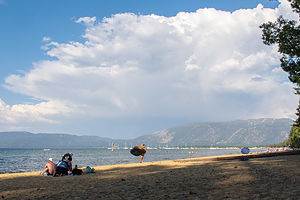 Camp Richardson Beach on Lake TahoeThere are many ways to drive back to Sonoma County from the Eastern Sierras,, but all of them involve a mountain pass of some sort – Tioga Pass, Sonora Pass, Monitor Pass, etc. Although still somewhat exciting, we have found that going north on 395 to Minden, Nevada, and then back south a bit through Luther Pass is the lesser of evils in terms of steepness and lengths of grades – and it has the added benefit of bringing us to South Lake Tahoe.
Camp Richardson Beach on Lake TahoeThere are many ways to drive back to Sonoma County from the Eastern Sierras,, but all of them involve a mountain pass of some sort – Tioga Pass, Sonora Pass, Monitor Pass, etc. Although still somewhat exciting, we have found that going north on 395 to Minden, Nevada, and then back south a bit through Luther Pass is the lesser of evils in terms of steepness and lengths of grades – and it has the added benefit of bringing us to South Lake Tahoe.
Our destination in South Lake Tahoe was Camp Richardson, a lakeside resort with RV camping, lodging, a full-service marina, and restaurant on the water. It was quite nice and really in the heart of things.
It was already late afternoon, so we loaded up the cooler with cheese and crackers and wine, and walked the short distance to a lovely beach on Tahoe’s southern shoreline. Before settling in to cocktail hour, I went for a 5 mile run along the paths through the nearby Tallac Historic site, which we had discovered on our visit here last year. As I have mentioned in so many previous posts, I love historical sites, especially those that let you step back in time for a vicarious peek into what life was like in a different time and place.
It was fun running past the beautiful old summer “cottages” built by three socially prominent San Francisco families back in the early 1900s and lovingly preserved by the Tahoe Heritage Foundation and the U. S. Forest Service. On certain days and times, the Baldwin Estate, Pope Estate, and Valhalla are open for public tours.
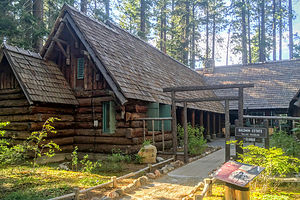 Tallac Historic SiteI rejoined Herb on the beach where we enjoyed sipping wine and watching sunset over the mountains by Emerald Bay.
Tallac Historic SiteI rejoined Herb on the beach where we enjoyed sipping wine and watching sunset over the mountains by Emerald Bay.
After dinner in the RV, I persuaded Herb to go for a walk in the dark through the Tallac Historic site, which we had done last year. Although they are called “estates,” they are actually rustic wooden lake houses with wraparound porches, complete with rocking chairs. And the best part of all is that you are allowed to wander onto the porches, peek in the windows, and even sit in the rockers. I’m surprised that there was no one else doing the same thing. It felt like we owned the place. It was so very cozy and peaceful.
The next morning we drove up to Secret Cove, one of a series of secluded, pristine beaches along Highway 28 on the remote Nevada eastern shore of the lake. It is one of Herb’s favorite beaches, which means a lot coming from a beach aficionado, so we come back to it every time we are in the area.
Along this section of the lake, the highway is way above the lake, so we had to hike down a fairly long, steep path to the beach, lugging our beach chairs, cooler, and tubes. Last time, we didn’t bring our tubes and I was so jealous watching everyone else bobbing happily around in the cove.
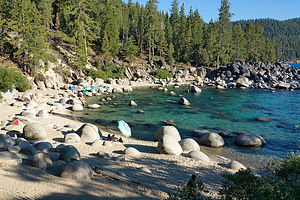 Secret Cove on Lake TahoeThis beach really is stunning – boulders scattered about a sandy beach, perfect for tucking behind for privacy or getting out of the wind that picks up every afternoon. And the water is so clear and incredibly deep Tahoe blue. It is a bit chilly though, but there are plenty of rocks and boulders in the cove to climb up on to dry off. The tubes kept us pretty dry as well.
Secret Cove on Lake TahoeThis beach really is stunning – boulders scattered about a sandy beach, perfect for tucking behind for privacy or getting out of the wind that picks up every afternoon. And the water is so clear and incredibly deep Tahoe blue. It is a bit chilly though, but there are plenty of rocks and boulders in the cove to climb up on to dry off. The tubes kept us pretty dry as well.
It was a lovely way to spend a summer afternoon.
When we got back at Camp Richardson that evening, we went back down to the beach to watch another beautiful sunset. Perhaps the next time we see this beautiful lake will be from the summit of Heavenly when we venture into our first West Coast downhill skiing.
Description
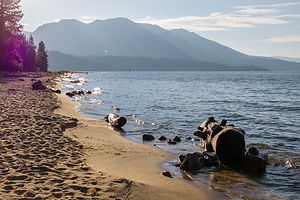 Baldwin Beach on Lake TahoeI am not even going to attempt to give a full description of what Lake Tahoe has to offer, as we only spent a short time on its southern shore.
Baldwin Beach on Lake TahoeI am not even going to attempt to give a full description of what Lake Tahoe has to offer, as we only spent a short time on its southern shore.
However, briefly, Lake Tahoe is one of the highest elevation lakes (6,255 feet high) in the U.S., as well as the second deepest (1,645 feet deep) – Crater Lake is the deepest. It is located along the border between California and Nevada. The four shores of the lake are each quite different. The north is quiet and upscale, the west and east are more rugged and less developed, and the south shore is busy and tacky with neon-lit hotels and casinos. The 72-mile drive around the lake is very scenic.
Lake Tahoe is known for its clear blue and green waters and the panorama of mountains that surround it on all sides. It is a year-round destination with swimming, boating, kayaking, and various other kinds of water sports during the summer; hiking, backpacking, and camping all year round; and tremendous skiing and snowboarding in the winter.
Two interesting nearby sites we did enjoy, include:
Tallac Historic Site
The Tallac Historic Site is comprised of three private estates dating back to the early 1900s, which served as summer retreats for three very socially prominent families from the San Francisco Bay area. In an effort to preserve “Old Tahoe,” the U.S. Forest Service acquired 74 acres, which included the three estates and a quarter mile of lakefront between Emerald Bay and Camp Richardson.
Today the remains of the restored estates attract thousands of visitors interested in recapturing this bygone and significant era in Tahoe’s history. Although the architecture of each is unique from its neighbors, each captures some aspect of the “Old Tahoe” style.
A list of activities and tours is available at the Visitor Center and the Baldwin museum.
